目的论在英文电影名称翻译中的应用
《2024年从目的论的角度谈英文电影片名的翻译》范文
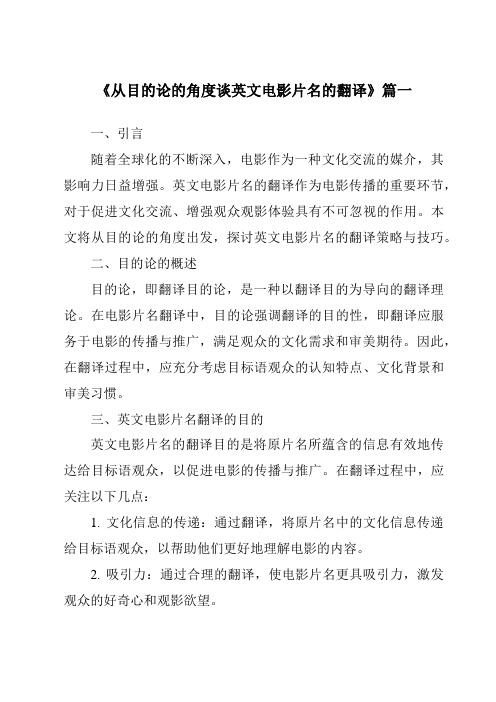
《从目的论的角度谈英文电影片名的翻译》篇一一、引言随着全球化的不断深入,电影作为一种文化交流的媒介,其影响力日益增强。
英文电影片名的翻译作为电影传播的重要环节,对于促进文化交流、增强观众观影体验具有不可忽视的作用。
本文将从目的论的角度出发,探讨英文电影片名的翻译策略与技巧。
二、目的论的概述目的论,即翻译目的论,是一种以翻译目的为导向的翻译理论。
在电影片名翻译中,目的论强调翻译的目的性,即翻译应服务于电影的传播与推广,满足观众的文化需求和审美期待。
因此,在翻译过程中,应充分考虑目标语观众的认知特点、文化背景和审美习惯。
三、英文电影片名翻译的目的英文电影片名的翻译目的是将原片名所蕴含的信息有效地传达给目标语观众,以促进电影的传播与推广。
在翻译过程中,应关注以下几点:1. 文化信息的传递:通过翻译,将原片名中的文化信息传递给目标语观众,以帮助他们更好地理解电影的内容。
2. 吸引力:通过合理的翻译,使电影片名更具吸引力,激发观众的好奇心和观影欲望。
3. 准确性:确保翻译的准确性,避免因误解原片名而导致的观众对电影内容的误解。
四、英文电影片名翻译的策略与技巧根据目的论的指导,英文电影片名的翻译应采用以下策略与技巧:1. 直译与意译相结合:在保证准确传达原片名信息的基础上,根据目标语观众的文化背景和审美习惯,灵活运用直译和意译的翻译方法。
例如,将《The Shawshank Redemption》(肖申克的救赎)译为“希望之光”,既保留了原片名的精髓,又使目标语观众更容易理解。
2. 简化与增补:对于一些过长或信息冗余的英文片名,可采用简化与增补的翻译方法。
简化是指将原片名中的冗余信息省略,只保留核心内容;增补则是在原片名的基础上添加相关信息,以帮助目标语观众更好地理解电影内容。
例如,《Jurassic Park》(侏罗纪公园)通过增补“恐龙”这一关键词,使目标语观众更易理解电影的主题。
3. 创新与再创造:在遵循翻译原则的基础上,可对原片名进行适当的创新与再创造。
目的论在英文电影片名翻译中的应用

目的论在英文电影片名翻译中的应用目的论在英文电影片名翻译中的应用导语:英文电影片名作为电影的名片,直接面向全球观众。
然而,不同语言和文化之间存在差异,使得片名翻译成为电影宣传的一个重要环节。
目的论作为一种翻译理论,可以在英文电影片名翻译中发挥重要作用。
本文将分析目的论在英文电影片名翻译中的应用,并探讨其对翻译效果的影响。
一、目的论在电影片名翻译中的基本原理目的论认为翻译的目的是为了达到某种特定的功能。
在电影片名翻译中,翻译目的主要体现在吸引观众、传递影片主题和增加广告效果等方面。
因此,在翻译过程中,翻译者要从这些方面考虑,以达到最佳的翻译效果。
二、目的论在吸引观众方面的应用吸引观众是电影片名翻译的重要目标之一。
翻译者可以通过创造性的手法来吸引观众的眼球。
比如,通过使用有趣、引人入胜的词语,或者运用一些文化隐喻和吸引人的符号,来激起观众的好奇心。
例如,电影《美女与野兽》(Beauty and the Beast),将片名译为中文《魔法美女》,充分利用了“魔法”和“美女”这两个概念,吸引了观众的注意力。
此外,目的论还强调影片的宣传效果。
翻译者可以通过简洁明了的片名,让观众在一瞬间就能记住电影并产生兴趣。
例如,电影《泰坦尼克号》(Titanic),将片名译为中文《泰坦尼克号》,简明扼要地表达了故事的背景和主题,从而引发观众的好奇心和兴趣。
三、目的论在传递主题方面的应用电影片名翻译不仅要吸引观众,还要能准确传达电影的主题。
翻译者需要深入理解电影的故事情节和主题意义,以便选择最合适的译名。
例如,电影《阿甘正传》(Forrest Gump),将片名译为中文《阿甘正传》,既准确传达了主人公的名字,又直接表达了电影的主题:一个普通人的非凡经历。
此外,目的论在传递电影主题方面还可以通过选择恰当的词语和符号来实现。
例如,电影《星际穿越》(Interstellar),将片名译为中文《星际启航》,用“星际”和“启航”这两个词表达了电影中人类对探索宇宙的渴望和勇往直前的精神。
翻译目的论视角下的英文电影片名的汉译
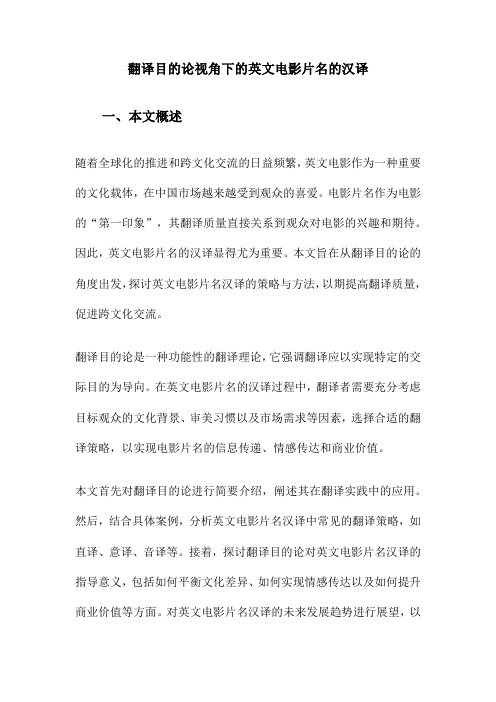
翻译目的论视角下的英文电影片名的汉译一、本文概述随着全球化的推进和跨文化交流的日益频繁,英文电影作为一种重要的文化载体,在中国市场越来越受到观众的喜爱。
电影片名作为电影的“第一印象”,其翻译质量直接关系到观众对电影的兴趣和期待。
因此,英文电影片名的汉译显得尤为重要。
本文旨在从翻译目的论的角度出发,探讨英文电影片名汉译的策略与方法,以期提高翻译质量,促进跨文化交流。
翻译目的论是一种功能性的翻译理论,它强调翻译应以实现特定的交际目的为导向。
在英文电影片名的汉译过程中,翻译者需要充分考虑目标观众的文化背景、审美习惯以及市场需求等因素,选择合适的翻译策略,以实现电影片名的信息传递、情感传达和商业价值。
本文首先对翻译目的论进行简要介绍,阐述其在翻译实践中的应用。
然后,结合具体案例,分析英文电影片名汉译中常见的翻译策略,如直译、意译、音译等。
接着,探讨翻译目的论对英文电影片名汉译的指导意义,包括如何平衡文化差异、如何实现情感传达以及如何提升商业价值等方面。
对英文电影片名汉译的未来发展趋势进行展望,以期为相关领域的翻译实践和研究提供参考。
二、翻译目的论在英文电影片名汉译中的应用翻译目的论为英文电影片名的汉译提供了全新的视角和理论支持。
在翻译过程中,翻译者不仅要考虑源语言和目标语言的文化差异,还需要充分考虑到电影片名的目的和功能,即吸引观众、传达电影主题等。
在英文电影片名的汉译中,翻译者通常会采用直译、意译、音译和创译等方法。
这些方法的选择和应用,往往取决于翻译者的翻译目的和对源语言和目标语言文化的理解。
例如,对于一些具有明确意象和象征意义的片名,翻译者可能会选择直译,以保持其原有的文化特色和艺术美感。
而对于一些难以直译或意译的片名,翻译者则可能会采用音译或创译的方法,以创造出新的、符合目标语言文化习惯的片名。
翻译目的论还强调翻译过程中的目标语言读者的接受度和反应。
因此,在英文电影片名的汉译中,翻译者还需要充分考虑到目标语言读者的审美习惯、文化背景和价值观等因素,以确保翻译后的片名能够引起目标语言读者的共鸣和兴趣。
《2024年从目的论的角度讨论英语电影片名翻译》范文

《从目的论的角度讨论英语电影片名翻译》篇一一、引言电影作为一种全球性的文化交流媒介,其片名翻译的准确性和艺术性至关重要。
随着英语电影的引进,片名的翻译已经成为观众获取影片信息和引起观影兴趣的重要手段。
目的论,作为一种重要的翻译理论,对于电影片名翻译的指导具有积极意义。
本文将从目的论的角度,对英语电影片名翻译进行深入探讨。
二、目的论概述目的论,又称功能翻译理论,强调翻译的目的性和功能。
在目的论的框架下,翻译被视为一种跨文化交际活动,其核心思想是翻译的目的是在目标语文化中实现与原语相同的交际效果。
在电影片名翻译中,这一理论有助于指导译者准确传达原片名所蕴含的信息和情感,以达到吸引观众的目的。
三、英语电影片名翻译的目的在英语电影片名翻译中,目的主要表现在以下几个方面:1. 传达原片信息:电影片名往往蕴含了影片的主题、情节和风格等信息,翻译时需准确传达这些信息。
2. 吸引观众注意:好的片名翻译能够引起观众的注意和兴趣,从而引导他们走进电影院。
3. 跨文化交流:通过翻译,实现不同文化之间的交流与融合,使电影在全球范围内得到传播。
四、目的论在英语电影片名翻译中的应用在目的论的指导下,英语电影片名翻译应遵循以下原则:1. 准确性:准确传达原片名所蕴含的信息和情感,确保观众能够理解影片的主题和内容。
2. 简洁性:片名应简洁明了,易于记忆和传播。
3. 文化适应性:考虑目标语文化的特点和观众的心理需求,进行适当的文化调整。
4. 艺术性:在准确传达信息的基础上,注重翻译的艺术性,使片名更具吸引力。
五、实例分析以《Titanic》为例,其中文译名为《泰坦尼克号》。
这个翻译准确传达了原片名的含义和情感色彩,同时也具有文化适应性。
在中文语境中,“泰坦尼克号”这一词汇具有一定的象征意义和历史记忆,容易引起观众的共鸣和兴趣。
此外,《Titanic》的译名简洁明了,易于记忆和传播。
这一成功的翻译案例体现了目的论在英语电影片名翻译中的实际应用价值。
《2024年翻译目的论视角下的英文电影片名的汉译》范文
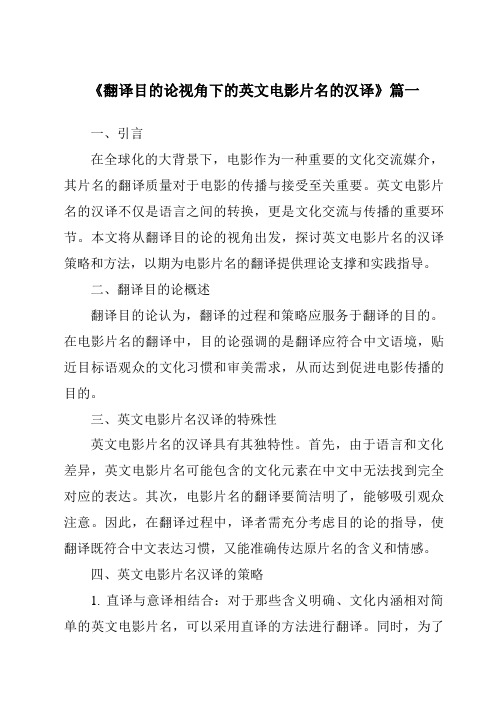
《翻译目的论视角下的英文电影片名的汉译》篇一一、引言在全球化的大背景下,电影作为一种重要的文化交流媒介,其片名的翻译质量对于电影的传播与接受至关重要。
英文电影片名的汉译不仅是语言之间的转换,更是文化交流与传播的重要环节。
本文将从翻译目的论的视角出发,探讨英文电影片名的汉译策略和方法,以期为电影片名的翻译提供理论支撑和实践指导。
二、翻译目的论概述翻译目的论认为,翻译的过程和策略应服务于翻译的目的。
在电影片名的翻译中,目的论强调的是翻译应符合中文语境,贴近目标语观众的文化习惯和审美需求,从而达到促进电影传播的目的。
三、英文电影片名汉译的特殊性英文电影片名的汉译具有其独特性。
首先,由于语言和文化差异,英文电影片名可能包含的文化元素在中文中无法找到完全对应的表达。
其次,电影片名的翻译要简洁明了,能够吸引观众注意。
因此,在翻译过程中,译者需充分考虑目的论的指导,使翻译既符合中文表达习惯,又能准确传达原片名的含义和情感。
四、英文电影片名汉译的策略1. 直译与意译相结合:对于那些含义明确、文化内涵相对简单的英文电影片名,可以采用直译的方法进行翻译。
同时,为了更好地贴近中文观众的文化习惯,有时需要辅以意译,使翻译更加地道。
2. 文化元素的转换:在翻译过程中,对于原片名中的文化元素,如人名、地名、典故等,需要进行适当的转换,以便中文观众能够更好地理解和接受。
3. 注重译文的可读性和吸引力:电影片名的翻译要简洁明了,能够吸引观众注意。
因此,在翻译过程中,要注重译文的可读性和吸引力,使翻译更加生动形象。
五、案例分析以电影《Titanic》为例,其汉译名为《泰坦尼克号》。
在翻译过程中,译者采用了直译的方法,同时辅以意译的技巧,使翻译既保留了原片名的文化内涵,又符合中文的表达习惯。
再如电影《The Shawshank Redemption》,其汉译名为《肖申克的救赎》,译者在翻译过程中充分考虑了中文的审美需求和文化背景,使翻译更加贴近中文观众的心理预期。
从目的论角度浅谈英文电影片名翻译
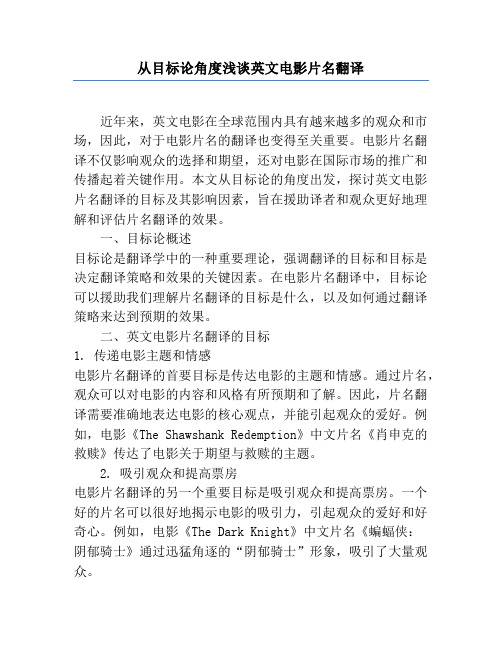
从目标论角度浅谈英文电影片名翻译近年来,英文电影在全球范围内具有越来越多的观众和市场,因此,对于电影片名的翻译也变得至关重要。
电影片名翻译不仅影响观众的选择和期望,还对电影在国际市场的推广和传播起着关键作用。
本文从目标论的角度出发,探讨英文电影片名翻译的目标及其影响因素,旨在援助译者和观众更好地理解和评估片名翻译的效果。
一、目标论概述目标论是翻译学中的一种重要理论,强调翻译的目标和目标是决定翻译策略和效果的关键因素。
在电影片名翻译中,目标论可以援助我们理解片名翻译的目标是什么,以及如何通过翻译策略来达到预期的效果。
二、英文电影片名翻译的目标1. 传递电影主题和情感电影片名翻译的首要目标是传达电影的主题和情感。
通过片名,观众可以对电影的内容和风格有所预期和了解。
因此,片名翻译需要准确地表达电影的核心观点,并能引起观众的爱好。
例如,电影《The Shawshank Redemption》中文片名《肖申克的救赎》传达了电影关于期望与救赎的主题。
2. 吸引观众和提高票房电影片名翻译的另一个重要目标是吸引观众和提高票房。
一个好的片名可以很好地揭示电影的吸引力,引起观众的爱好和好奇心。
例如,电影《The Dark Knight》中文片名《蝙蝠侠:阴郁骑士》通过迅猛角逐的“阴郁骑士”形象,吸引了大量观众。
3. 适应不同的文化和语言环境电影片名翻译还需要思量不同的文化和语言环境。
片名需要在不同的国家和地区得到理解和接受,因此对于特定的文化和语言背景,片名翻译需要进行相应的调整。
例如,电影《La La Land》中文片名《爱乐之城》使用了中国传统音乐与现代都市的对比,既传达了电影主题,又适应了中国观众对文化元素的接受习惯。
三、影响英文电影片名翻译的因素1. 文化差异不同的文化背景会对片名翻译产生重要影响。
由于不同的文化具有不同的价值观和符号体系,有些片名可能需要进行文化适应和调整。
例如,电影《Lost in Translation》中文片名《迷失东京》试图将电影的情感主题与观众熟识的东京背景进行联系,以更好地吸引观众。
《2024年浅谈目的论视角下的英文电影片名的汉译》范文

《浅谈目的论视角下的英文电影片名的汉译》篇一一、引言在全球化日益盛行的今天,英文电影的汉译显得尤为重要。
英文电影片名的翻译不仅是语言转换的体现,更是文化传播的桥梁。
它关乎到观众对电影的第一印象,也影响着电影的票房和影响力。
本文将从目的论的视角出发,探讨英文电影片名的汉译策略和技巧。
二、目的论视角下的翻译目的论是翻译研究中的一个重要理论,它认为翻译的目的决定了翻译的策略和方法。
在英文电影片名的汉译中,目的论同样适用。
翻译的目的往往是为了让观众更好地理解电影内容,同时传递电影的精髓和风格。
因此,在翻译过程中,译者需要充分理解原片名的含义和风格,同时考虑到目标观众的文化背景和审美习惯。
三、英文电影片名汉译的策略1. 直译法:对于一些含义明确、文化内涵较浅的电影片名,可以采用直译法。
这种方法可以保留原片名的语言特点和文化元素,让观众对电影有一个初步的了解。
2. 意译法:对于一些抽象、寓意深长的电影片名,可以采用意译法。
这种方法更注重传达电影的主题和情感,使译文更加贴近观众的审美习惯。
3. 创造性翻译:在保持原片名基本含义的前提下,可以运用修辞手法和文化元素,进行创造性的翻译。
这种方法可以使译文更加生动形象,更具吸引力。
四、英文电影片名汉译的技巧1. 简练明了:电影片名的翻译应该简练明了,避免冗长的词汇和复杂的句式。
这样可以让观众更容易记住和理解。
2. 突出主题:翻译时应该突出电影的主题和情感,使观众对电影有一个初步的判断。
3. 考虑文化差异:在翻译过程中,应该充分考虑中西方文化的差异,避免因文化误解而导致的翻译失误。
4. 运用修辞手法:可以适当运用修辞手法和文化元素,使译文更具艺术性和吸引力。
五、结论英文电影片名的汉译是一项具有挑战性的任务。
在目的论的指导下,我们应该充分理解原片名的含义和风格,同时考虑到目标观众的文化背景和审美习惯。
在翻译过程中,我们可以采用直译法、意译法和创造性翻译等方法,同时运用简练明了、突出主题、考虑文化差异和运用修辞手法等技巧。
《2024年从目的论角度浅谈英文电影片名翻译》范文
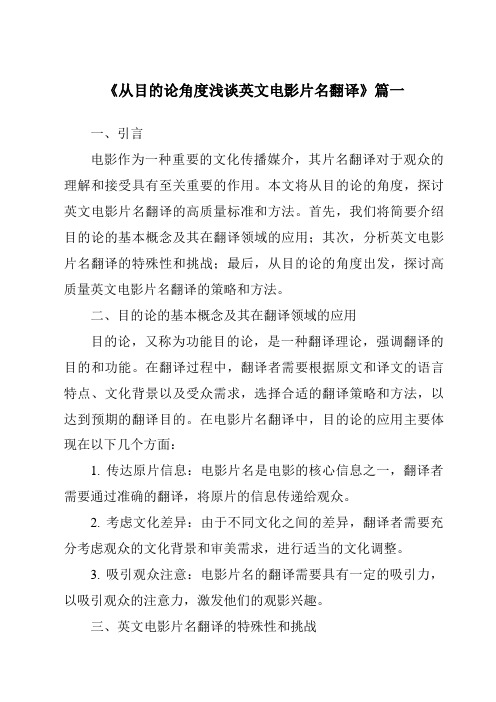
《从目的论角度浅谈英文电影片名翻译》篇一一、引言电影作为一种重要的文化传播媒介,其片名翻译对于观众的理解和接受具有至关重要的作用。
本文将从目的论的角度,探讨英文电影片名翻译的高质量标准和方法。
首先,我们将简要介绍目的论的基本概念及其在翻译领域的应用;其次,分析英文电影片名翻译的特殊性和挑战;最后,从目的论的角度出发,探讨高质量英文电影片名翻译的策略和方法。
二、目的论的基本概念及其在翻译领域的应用目的论,又称为功能目的论,是一种翻译理论,强调翻译的目的和功能。
在翻译过程中,翻译者需要根据原文和译文的语言特点、文化背景以及受众需求,选择合适的翻译策略和方法,以达到预期的翻译目的。
在电影片名翻译中,目的论的应用主要体现在以下几个方面:1. 传达原片信息:电影片名是电影的核心信息之一,翻译者需要通过准确的翻译,将原片的信息传递给观众。
2. 考虑文化差异:由于不同文化之间的差异,翻译者需要充分考虑观众的文化背景和审美需求,进行适当的文化调整。
3. 吸引观众注意:电影片名的翻译需要具有一定的吸引力,以吸引观众的注意力,激发他们的观影兴趣。
三、英文电影片名翻译的特殊性和挑战英文电影片名翻译具有其特殊性和挑战性。
首先,由于语言和文化差异,翻译者需要准确理解原片名的含义和情感色彩;其次,电影片名往往具有文化内涵和象征意义,需要进行深入的文化解读;最后,翻译者还需要考虑观众的需求和审美标准,使翻译结果更加贴近观众的实际需求。
四、从目的论角度探讨高质量英文电影片名翻译的策略和方法从目的论的角度出发,高质量的英文电影片名翻译应遵循以下策略和方法:1. 准确传达原片信息:翻译者需要准确理解原片名的含义和情感色彩,确保译文与原文在信息传递上保持一致。
2. 考虑文化差异和文化解读:翻译者需要充分考虑观众的文化背景和审美需求,进行适当的文化调整和解读,以使译文更加贴近观众的实际需求。
3. 吸引观众注意:电影片名的翻译需要具有一定的吸引力,以激发观众的观影兴趣。
《2024年从目的论角度浅谈英文电影片名翻译》范文

《从目的论角度浅谈英文电影片名翻译》篇一一、引言在全球化背景下,电影作为一种重要的文化传播媒介,其片名的翻译质量对于影片的推广和接受度起着至关重要的作用。
本文将从目的论的角度,对英文电影片名的翻译进行浅显的探讨,旨在揭示高质量翻译的要点和方法。
二、目的论的基本概念目的论,即翻译的目的决定翻译的方法和策略。
在电影片名的翻译中,目的论强调的是翻译应服务于影片的推广和观众的接受。
因此,翻译的目的不仅仅是传达原片名的意义,更是要激发观众的兴趣,引导他们走进电影院。
三、英文电影片名翻译的特点英文电影片名的翻译具有其独特性,需要考虑到文化差异、语言习惯、市场接受度等因素。
高质量的翻译应准确传达原片名的含义,同时考虑到目标语观众的审美和接受习惯。
四、从目的论角度看英文电影片名翻译从目的论的角度出发,英文电影片名的翻译应遵循以下原则:1. 文化适应性:翻译应考虑到目标语文化的背景和习惯,避免因文化差异造成的误解。
例如,一些具有象征意义的词汇在一种文化中可能具有特殊含义,在另一种文化中可能并无特别含义。
因此,在翻译时需要对这些词汇进行适当的调整,以适应目标语文化。
2. 市场导向性:翻译的目的应是引导观众走进电影院。
因此,翻译应具有吸引力,能够引起观众的兴趣。
在翻译过程中,可以考虑使用一些具有吸引力的词汇和表达方式,以增加影片的吸引力。
3. 信息传递性:尽管电影片名的翻译需要考虑到文化差异和语言习惯,但基本信息和主题的传递仍是关键。
因此,在翻译过程中,应确保基本信息和主题的准确传递,以帮助观众了解影片内容。
五、高质量英文电影片名翻译的实践案例以《泰坦尼克号》为例,其英文原名为“Titanic”,在翻译成中文时,采用了具有象征意义的“泰坦尼克号”这一名称。
这一翻译不仅准确传达了原片名的基本信息,还具有强烈的视觉冲击力,能够引起观众的兴趣。
再如《阿甘正传》的英文原名“Forrest Gump”,在翻译时充分考虑了中文的表达习惯和文化背景,将原名中的核心信息“阿甘”和故事主题“正传”相结合,形成了具有吸引力的中文片名。
《2024年目的论在英文电影片名翻译中的应用》范文
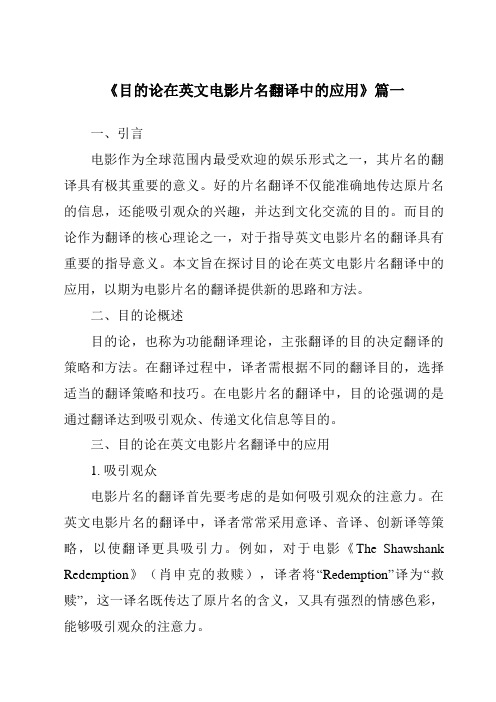
《目的论在英文电影片名翻译中的应用》篇一一、引言电影作为全球范围内最受欢迎的娱乐形式之一,其片名的翻译具有极其重要的意义。
好的片名翻译不仅能准确地传达原片名的信息,还能吸引观众的兴趣,并达到文化交流的目的。
而目的论作为翻译的核心理论之一,对于指导英文电影片名的翻译具有重要的指导意义。
本文旨在探讨目的论在英文电影片名翻译中的应用,以期为电影片名的翻译提供新的思路和方法。
二、目的论概述目的论,也称为功能翻译理论,主张翻译的目的决定翻译的策略和方法。
在翻译过程中,译者需根据不同的翻译目的,选择适当的翻译策略和技巧。
在电影片名的翻译中,目的论强调的是通过翻译达到吸引观众、传递文化信息等目的。
三、目的论在英文电影片名翻译中的应用1. 吸引观众电影片名的翻译首先要考虑的是如何吸引观众的注意力。
在英文电影片名的翻译中,译者常常采用意译、音译、创新译等策略,以使翻译更具吸引力。
例如,对于电影《The Shawshank Redemption》(肖申克的救赎),译者将“Redemption”译为“救赎”,这一译名既传达了原片名的含义,又具有强烈的情感色彩,能够吸引观众的注意力。
2. 传递文化信息电影作为文化传播的载体,其片名往往蕴含着丰富的文化信息。
在英文电影片名的翻译中,译者需充分考虑文化差异,通过适当的翻译策略将原片名中的文化信息准确地传达给目标语观众。
例如,对于电影《Forrest Gump》(阿甘正传),译者将“Gump”这一具有南方口音的名称保留下来,使得观众能够感受到原片的南方文化特色。
3. 灵活运用翻译策略在英文电影片名的翻译中,译者需根据不同的翻译目的和原片名的特点,灵活运用各种翻译策略。
如对于具有特殊文化内涵的片名,可采用音译加注的方法进行翻译;对于具有故事性的片名,可采用意译的方法进行翻译;而对于一些具有特殊意义的词语或短语,则可采用创新译的方法进行翻译。
这些策略的运用旨在使翻译更加贴合目标语的文化背景和语言习惯。
从目的论角度浅谈英文电影片名翻译
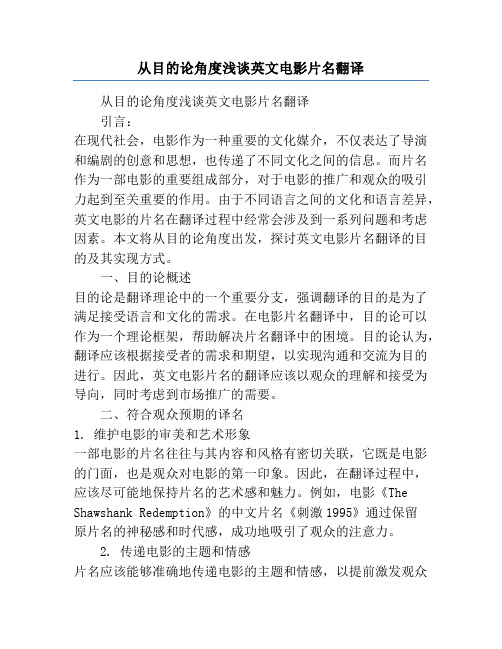
从目的论角度浅谈英文电影片名翻译从目的论角度浅谈英文电影片名翻译引言:在现代社会,电影作为一种重要的文化媒介,不仅表达了导演和编剧的创意和思想,也传递了不同文化之间的信息。
而片名作为一部电影的重要组成部分,对于电影的推广和观众的吸引力起到至关重要的作用。
由于不同语言之间的文化和语言差异,英文电影的片名在翻译过程中经常会涉及到一系列问题和考虑因素。
本文将从目的论角度出发,探讨英文电影片名翻译的目的及其实现方式。
一、目的论概述目的论是翻译理论中的一个重要分支,强调翻译的目的是为了满足接受语言和文化的需求。
在电影片名翻译中,目的论可以作为一个理论框架,帮助解决片名翻译中的困境。
目的论认为,翻译应该根据接受者的需求和期望,以实现沟通和交流为目的进行。
因此,英文电影片名的翻译应该以观众的理解和接受为导向,同时考虑到市场推广的需要。
二、符合观众预期的译名1. 维护电影的审美和艺术形象一部电影的片名往往与其内容和风格有密切关联,它既是电影的门面,也是观众对电影的第一印象。
因此,在翻译过程中,应该尽可能地保持片名的艺术感和魅力。
例如,电影《The Shawshank Redemption》的中文片名《刺激1995》通过保留原片名的神秘感和时代感,成功地吸引了观众的注意力。
2. 传递电影的主题和情感片名应该能够准确地传递电影的主题和情感,以提前激发观众的兴趣。
例如,电影《The Notebook》的中文片名《恋恋笔记本》通过直接翻译表达出了电影浪漫而感人的情感。
3. 适应观众的文化背景和语言习惯鉴于片名是观众对电影的第一印象,应该根据观众的文化背景和语言习惯进行适当的调整和改编。
例如,电影《Silver Linings Playbook》的中文片名《乌云背后的幸福线》通过直观地反映电影的情节和主题,更贴近中国观众的审美和口味。
三、市场宣传的考虑1. 突出电影的卖点和特色电影片名翻译应该突出电影的卖点和特色,以吸引观众的关注。
《2024年浅谈目的论视角下的英文电影片名的汉译》范文

《浅谈目的论视角下的英文电影片名的汉译》篇一一、引言随着全球化的推进,电影作为一种重要的文化交流媒介,其片名的翻译显得尤为重要。
英文电影片名的汉译不仅关乎电影的宣传推广,也直接影响着观众对电影的第一印象。
本文将从目的论的视角出发,探讨英文电影片名汉译的策略和方法。
二、目的论视角下的翻译目的论认为,翻译是一种有目的的交际行为。
在翻译过程中,译者需根据翻译目的,选择合适的翻译策略和方法。
对于英文电影片名的汉译而言,其目的在于使中文观众能够准确理解电影的内容和主题,同时吸引他们的注意力,激发观影兴趣。
三、英文电影片名汉译的策略1. 直译与意译相结合直译能够保留原片名的语言特色,使观众对原作有更深入的了解。
然而,直译有时会因为文化差异而导致理解上的困惑。
因此,需要结合意译,用更符合中文表达习惯的方式进行翻译。
例如,英文电影名“The Shawshank Redemption”可以翻译为“肖申克的救赎”,既保留了原名的结构特点,又充分传达了电影的主题。
2. 增译与减译增译是指在翻译过程中增加一些原文中没有但中文表达中必要的词汇,以使译文更加完整、流畅。
减译则是为了使译文更加简洁明了,去除一些冗余的词汇或结构。
在电影片名翻译中,增译和减译常常需要根据中文表达习惯进行适当的调整。
例如,“Forrest Gump”在中文中翻译为“阿甘正传”,增加了对电影主题的解读和宣传效果。
四、实例分析以经典英文电影“The Dark Knight”(黑暗骑士)为例,该电影的中文片名为“蝙蝠侠:黑暗骑士”。
这个翻译成功地将“Dark Knight”翻译为具有神秘、英雄气质的“蝙蝠侠”,并且与主题“黑暗骑士”紧密结合,达到了宣传效果。
这一案例充分体现了目的论在英文电影片名汉译中的应用。
五、结论在目的论视角下,英文电影片名的汉译需遵循一定的策略和方法。
通过直译与意译相结合、增译与减译等手段,使中文观众能够准确理解电影的内容和主题,同时激发他们的观影兴趣。
《2024年目的论在电影名翻译中的运用》范文

《目的论在电影名翻译中的运用》篇一一、引言随着全球化的推进,电影作为一种文化交流的重要媒介,其翻译质量显得尤为重要。
电影名的翻译作为电影宣传和推广的关键环节,其翻译的准确性和吸引力直接影响到观众的接受程度。
目的论作为翻译理论的重要组成部分,在电影名翻译中发挥着重要作用。
本文旨在探讨目的论在电影名翻译中的运用,分析其重要性和应用策略。
二、目的论概述目的论是一种翻译理论,强调翻译的目的性和跨文化交际的功能。
在电影名翻译中,目的论认为翻译的目的不仅是传达原意,更是要吸引观众,促进电影的传播和推广。
因此,翻译者需要根据目标语文化背景、观众心理和市场需求等因素,灵活运用翻译策略,使电影名在目标语中达到最佳效果。
三、目的论在电影名翻译中的应用1. 文化适应策略在电影名翻译中,文化差异是一个不可忽视的因素。
翻译者需要充分考虑目标语文化背景和观众心理,采用文化适应策略,使电影名在目标语中产生共鸣。
例如,将英文电影名“The Shawshank Redempt ion”译为中文的“肖申克的救赎”,既保留了原名的含义,又符合中文表达习惯,使观众更容易产生共鸣。
2. 突出卖点策略在市场竞争激烈的电影行业中,吸引观众的关键在于突出电影的卖点。
翻译者需要通过精准的翻译,将电影的亮点和卖点突出出来,吸引观众的注意力。
例如,将电影名“Inception”译为“盗梦空间”,突出了电影的悬念和奇幻元素,为观众带来了强烈的视觉冲击。
3. 直译与意译相结合策略直译与意译相结合是电影名翻译中常用的策略。
在保证准确传达原意的基础上,翻译者需要灵活运用直译和意译手法,使电影名更具吸引力和感染力。
例如,将电影名“The Wolf of Wall Street”译为“华尔街之狼”,既保留了原名的意象,又符合中文表达习惯,突出了电影的主题。
四、案例分析以近两年热门的电影《疯狂的石头》和《泰坦尼克号》为例。
在《疯狂的石头》的翻译中,译者保留了原名的意象和情感色彩,同时又突出了幽默和搞笑的元素;而在《泰坦尼克号》的翻译中,则突出了影片的历史背景和宏大的主题。
目的论在电影名翻译中的运用

目的论在电影名翻译中的运用目的论在电影名翻译中的运用1. 引言电影作为一种世界性的艺术形式,其翻译是跨文化交流中最重要的环节之一。
电影名作为电影的品牌,承载着电影的主题、风格和宣传效果,其翻译准确与否直接影响到电影的传播和观众的理解。
为了满足观众的需求和推广电影,翻译工作者需要灵活运用不同的翻译方法和策略。
本文将探讨目的论在电影名翻译中的运用,以期提供一些启示和借鉴。
2. 目的论的基本概念目的论是翻译学中的一个重要理论,强调翻译的目的和功能。
根据目的论的观点,翻译的目的是满足接受文化中的需求,而翻译策略应根据目标文化的接受能力和观众的认知方式来确定。
3. 目的论在电影名翻译中的应用3.1 文化转换在电影名翻译中,文化转换是目的论的核心之一。
不同语言和文化间存在着巨大的差异,这就需要翻译工作者在传达电影的主题和风格的同时,考虑目标文化的接受程度和认知方式。
比如,英文电影名中常使用的幽默和双关的元素,在中文翻译中往往需要进行重新设计,以适应中国观众的口味和习惯。
这种文化转换的策略旨在使电影名更具吸引力和传播效果。
3.2 艺术再现电影名作为艺术品的一部分,翻译时需要注意尊重原作和保持艺术性。
目的论的观点指出,翻译应根据观众的需求来进行,同时也要尊重电影的风格和主题。
例如,对于一些具有强烈艺术气息的电影,翻译时可以采用意译的方式,以保留原作的独特性和美感。
3.3 市场推广电影名翻译还需要考虑市场推广的目的和效果。
不同的电影类型和受众群体对于电影名的要求不同,因此翻译工作者需要根据目标市场的需求来进行翻译。
一些商业片的电影名可能更注重吸引眼球和提升观众的期待,而一些艺术片则更注重传达电影的主题和情感。
4. 目的论在电影名翻译中的挑战和解决方法4.1 语言差异不同语言间存在着语法、简繁体字、表达方式等方面的差异,这给电影名的翻译带来了挑战。
为了克服这些困难,翻译工作者需要熟悉目标语言和文化,并运用目的论的原则进行适当调整和转换。
《2024年目的论在电影名翻译中的运用》范文
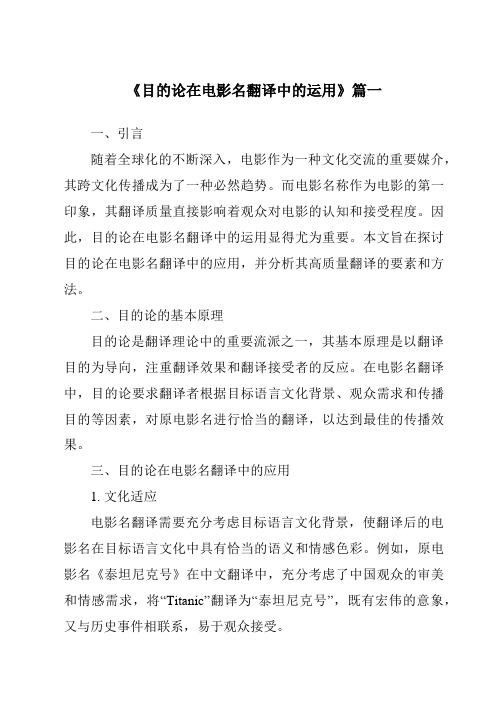
《目的论在电影名翻译中的运用》篇一一、引言随着全球化的不断深入,电影作为一种文化交流的重要媒介,其跨文化传播成为了一种必然趋势。
而电影名称作为电影的第一印象,其翻译质量直接影响着观众对电影的认知和接受程度。
因此,目的论在电影名翻译中的运用显得尤为重要。
本文旨在探讨目的论在电影名翻译中的应用,并分析其高质量翻译的要素和方法。
二、目的论的基本原理目的论是翻译理论中的重要流派之一,其基本原理是以翻译目的为导向,注重翻译效果和翻译接受者的反应。
在电影名翻译中,目的论要求翻译者根据目标语言文化背景、观众需求和传播目的等因素,对原电影名进行恰当的翻译,以达到最佳的传播效果。
三、目的论在电影名翻译中的应用1. 文化适应电影名翻译需要充分考虑目标语言文化背景,使翻译后的电影名在目标语言文化中具有恰当的语义和情感色彩。
例如,原电影名《泰坦尼克号》在中文翻译中,充分考虑了中国观众的审美和情感需求,将“Titanic”翻译为“泰坦尼克号”,既有宏伟的意象,又与历史事件相联系,易于观众接受。
2. 精准传达信息电影名翻译需要准确传达原电影的主题、风格和情节等信息,使观众能够通过电影名对电影内容有所了解。
例如,原电影名《疯狂的石头》在英文翻译中,保留了原意中的幽默和诙谐元素,同时通过“Crazy Stone”这一简洁明了的表达方式,准确传达了原电影的主题和情节。
3. 营销策略电影名翻译需要考虑市场推广和营销策略,使翻译后的电影名具有一定的吸引力和宣传效果。
例如,原电影名《阿凡达》在中文翻译中,运用了神秘、奇幻的词汇,引发了观众的好奇心和探究欲望,为电影的宣传和推广起到了积极的推动作用。
四、高质量电影名翻译的要素和方法1. 要素:准确性、文化敏感性和可读性准确性是电影名翻译的首要要素,要求翻译者对原电影名进行准确的理解和表达。
文化敏感性要求翻译者充分考虑目标语言文化背景和观众需求,使翻译后的电影名具有恰当的语义和情感色彩。
可读性则要求翻译后的电影名简洁明了、易于理解,使观众能够轻松获取信息。
目的论在电影名翻译中的运用

目的论在电影名翻译中的运用目的论在电影名翻译中的运用导语电影作为一种重要的娱乐形式和文化表达方式,在全球范围都产生了巨大影响。
然而,由于不同国家、不同文化之间的语言差异和文化差异,电影在全球范围内的传播和推广会受到很大的限制。
因此,在电影传播过程中,翻译起着至关重要的作用。
本文将探讨在电影名翻译中运用目的论的实践和应用。
第一部分:目的论概述目的论(Skopos theory)是由德国翻译学家Hans J. Vermeer在20世纪80年代发展起来的一种翻译理论。
目的论的核心观点是翻译必须根据特定的目的进行,翻译的最终目的是满足所追求的目标。
在电影名翻译中,翻译者必须了解电影的宣传目的、受众需求和文化背景,将原电影名传达给目标语受众。
第二部分:电影名翻译原则2.1 信达雅原则翻译过程中,必须保证在意义传达的基础上,尽量忠实于原文的风格与情感。
对于电影名翻译来说,这意味着翻译者需要保留原文的情感、寓意和韵味,并在目标语文化背景下灵活运用。
2.2 易记易发音原则电影名作为一种商业标识,需要能够轻易被受众记住和发音。
因此,翻译者应该注意选择易于发音和记忆的译文,以增加电影在目标市场的知名度和影响力。
2.3 文化适应原则由于不同国家和地区的文化差异,电影名在不同的文化背景下有不同的影响力和吸引力。
因此,在翻译电影名时,翻译者应该充分考虑目标市场的文化差异,采用符合当地文化的译名,提高电影的可接受性和欣赏度。
第三部分:目的论在电影名翻译中的运用实例3.1 流行电影名的翻译对于一些广为流传的电影名,翻译者可以选择将其直接音译或者意译成目标语言。
例如,美国电影《The Shawshank Redemption》在中国被翻译为《肖申克的救赎》,这个译名在目标市场引起了广泛的共鸣,并使该电影在中国获得了很高的评价和影响力。
3.2 文化差异的处理在处理文化差异时,翻译者需要根据目标市场的需求进行调整。
例如,英国电影《Love Actually》在中国被翻译为《真爱至上》,这个译名更符合中国观众对浪漫爱情题材的理解和喜好。
《2024年目的论在电影名翻译中的运用》范文

《目的论在电影名翻译中的运用》篇一一、引言随着全球化的不断深入,电影作为一种文化交流的重要媒介,其跨文化传播成为了一个重要的研究领域。
电影名称作为电影的第一印象,其翻译的准确性和吸引力直接影响到电影的票房和国际影响力。
目的论作为一种翻译理论,为电影名翻译提供了重要的指导。
本文旨在探讨目的论在电影名翻译中的运用,并分析其效果。
二、目的论的基本原理目的论,又称为目的性行为理论,强调翻译行为的目的性和交际性。
在电影名翻译中,目的论要求译者以目标观众为出发点,理解并满足他们的文化需求和审美习惯。
在翻译过程中,译者需关注信息的传达、文化背景的融合以及语言的可接受性。
三、目的论在电影名翻译中的运用1. 文化信息的传达电影名翻译需准确传达电影的文化信息,以引起目标观众的共鸣。
例如,电影《The Shawshank Redemption》(《肖申克的救赎》)的中文译名,既保留了原名的意象,又准确地传达了电影所表达的主题和情感。
这得益于译者对西方监狱文化和自由追求的深刻理解。
2. 语言的可接受性电影名翻译需考虑语言的可接受性,使目标观众能够轻松理解和接受。
例如,电影《The Matrix》(《黑客帝国》)的中文译名,采用了意译的方式,将原名的意象和故事内容巧妙地结合起来,使中文观众能够轻松理解。
3. 文化背景的融合电影名翻译需考虑文化背景的融合,使电影在跨文化传播中更好地融入目标文化。
例如,中国电影《卧虎藏龙》在翻译成英文时,保留了原名的意象和文化内涵,使西方观众能够更好地理解和欣赏这部具有中国特色的电影。
四、案例分析以好莱坞大片《Titanic》(《泰坦尼克号》)为例,其中文译名成功地传达了电影的主题和情感。
译者将“Titanic”这一名字与中国的文化背景相结合,运用了修辞手法,使译名既具有美感又易于理解。
这一成功的翻译案例充分体现了目的论在电影名翻译中的运用。
五、结论目的论在电影名翻译中具有重要意义。
它要求译者以目标观众为出发点,准确传达文化信息,关注语言的可接受性和文化背景的融合。
《2024年目的论在英文电影片名翻译中的应用》范文
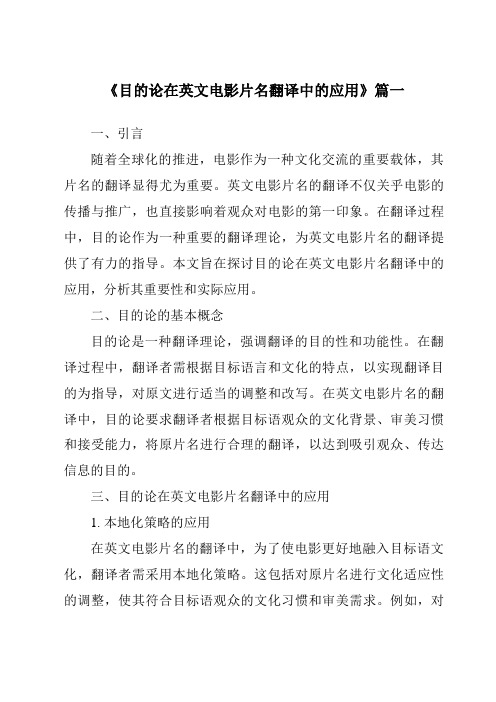
《目的论在英文电影片名翻译中的应用》篇一一、引言随着全球化的推进,电影作为一种文化交流的重要载体,其片名的翻译显得尤为重要。
英文电影片名的翻译不仅关乎电影的传播与推广,也直接影响着观众对电影的第一印象。
在翻译过程中,目的论作为一种重要的翻译理论,为英文电影片名的翻译提供了有力的指导。
本文旨在探讨目的论在英文电影片名翻译中的应用,分析其重要性和实际应用。
二、目的论的基本概念目的论是一种翻译理论,强调翻译的目的性和功能性。
在翻译过程中,翻译者需根据目标语言和文化的特点,以实现翻译目的为指导,对原文进行适当的调整和改写。
在英文电影片名的翻译中,目的论要求翻译者根据目标语观众的文化背景、审美习惯和接受能力,将原片名进行合理的翻译,以达到吸引观众、传达信息的目的。
三、目的论在英文电影片名翻译中的应用1. 本地化策略的应用在英文电影片名的翻译中,为了使电影更好地融入目标语文化,翻译者需采用本地化策略。
这包括对原片名进行文化适应性的调整,使其符合目标语观众的文化习惯和审美需求。
例如,对于一些具有地域特色的电影片名,翻译者需在保持原意的基础上,加入目标语地域文化的元素,以增强观众的共鸣。
2. 情感色彩的传达电影片名往往蕴含着丰富的情感色彩,因此在翻译过程中,翻译者需注重情感色彩的传达。
通过运用目的论,翻译者可以更好地把握原片名的情感基调,将其准确地传达给目标语观众。
例如,一些浪漫爱情电影的片名在翻译时需注重表达爱情、温柔等情感色彩,以激发观众的观影欲望。
3. 市场推广的考虑电影片名的翻译还需考虑市场推广的因素。
通过运用目的论,翻译者可以更好地了解目标语市场的需求和趋势,为电影的市场推广提供有力的支持。
例如,对于一些面向年轻观众的电影,翻译者需采用更具创意和吸引力的翻译方式,以增加电影的曝光度和吸引力。
四、案例分析以电影《Titanic》为例,其原名为“泰坦尼克号”。
在翻译过程中,翻译者充分考虑了目的论的指导原则。
目的论在电影名翻译中的运用
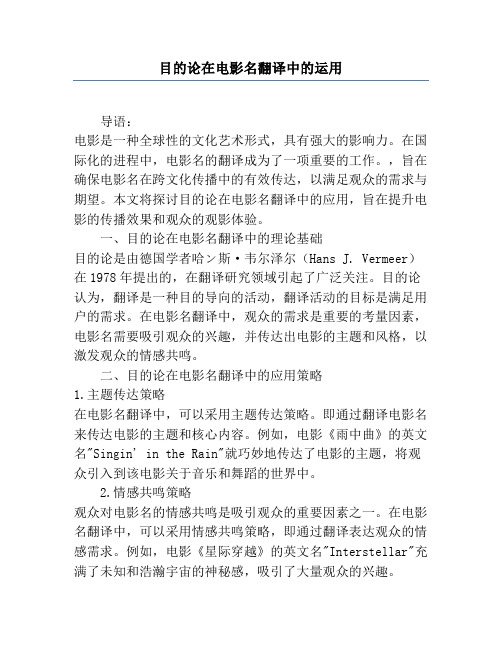
目的论在电影名翻译中的运用导语:电影是一种全球性的文化艺术形式,具有强大的影响力。
在国际化的进程中,电影名的翻译成为了一项重要的工作。
,旨在确保电影名在跨文化传播中的有效传达,以满足观众的需求与期望。
本文将探讨目的论在电影名翻译中的应用,旨在提升电影的传播效果和观众的观影体验。
一、目的论在电影名翻译中的理论基础目的论是由德国学者哈ン斯·韦尔泽尔(Hans J. Vermeer)在1978年提出的,在翻译研究领域引起了广泛关注。
目的论认为,翻译是一种目的导向的活动,翻译活动的目标是满足用户的需求。
在电影名翻译中,观众的需求是重要的考量因素,电影名需要吸引观众的兴趣,并传达出电影的主题和风格,以激发观众的情感共鸣。
二、目的论在电影名翻译中的应用策略1.主题传达策略在电影名翻译中,可以采用主题传达策略。
即通过翻译电影名来传达电影的主题和核心内容。
例如,电影《雨中曲》的英文名"Singin' in the Rain"就巧妙地传达了电影的主题,将观众引入到该电影关于音乐和舞蹈的世界中。
2.情感共鸣策略观众对电影名的情感共鸣是吸引观众的重要因素之一。
在电影名翻译中,可以采用情感共鸣策略,即通过翻译表达观众的情感需求。
例如,电影《星际穿越》的英文名"Interstellar"充满了未知和浩瀚宇宙的神秘感,吸引了大量观众的兴趣。
3.文化因素考量策略目的论在电影名翻译中也要考虑到文化因素的影响。
不同的文化背景对电影名的理解和接受会有所不同。
因此,在翻译电影名时,需要根据目标文化的习惯和偏好进行适当调整。
例如,电影《终结者》的英文名"The Terminator"直接表达了电影的主题,但在中国被翻译成了"终结者",更符合中国观众的接受习惯。
三、目的论在电影名翻译中的挑战与对策1.语义差异挑战不同语言之间存在着语义差异,这给电影名翻译带来了挑战。
目的论在英文电影片名翻译中的应用的开题报告
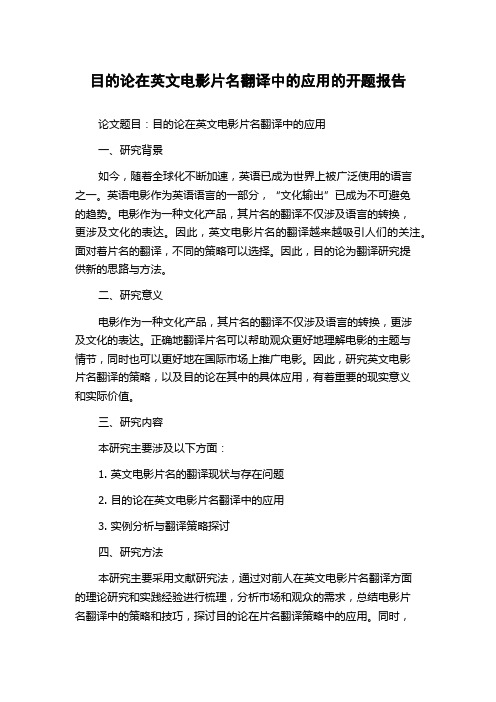
目的论在英文电影片名翻译中的应用的开题报告论文题目:目的论在英文电影片名翻译中的应用一、研究背景如今,随着全球化不断加速,英语已成为世界上被广泛使用的语言之一。
英语电影作为英语语言的一部分,“文化输出”已成为不可避免的趋势。
电影作为一种文化产品,其片名的翻译不仅涉及语言的转换,更涉及文化的表达。
因此,英文电影片名的翻译越来越吸引人们的关注。
面对着片名的翻译,不同的策略可以选择。
因此,目的论为翻译研究提供新的思路与方法。
二、研究意义电影作为一种文化产品,其片名的翻译不仅涉及语言的转换,更涉及文化的表达。
正确地翻译片名可以帮助观众更好地理解电影的主题与情节,同时也可以更好地在国际市场上推广电影。
因此,研究英文电影片名翻译的策略,以及目的论在其中的具体应用,有着重要的现实意义和实际价值。
三、研究内容本研究主要涉及以下方面:1. 英文电影片名的翻译现状与存在问题2. 目的论在英文电影片名翻译中的应用3. 实例分析与翻译策略探讨四、研究方法本研究主要采用文献研究法,通过对前人在英文电影片名翻译方面的理论研究和实践经验进行梳理,分析市场和观众的需求,总结电影片名翻译中的策略和技巧,探讨目的论在片名翻译策略中的应用。
同时,本研究将通过具体案例分析来进一步验证目的论在电影片名翻译中的可行性和有效性。
五、研究结论本研究将最终总结出英文电影片名翻译中的策略和技巧,探讨目的论在片名翻译策略中的应用,并通过案例分析来验证其实际应用价值。
同时,将总结出目的论在英文电影片名翻译中的优势和局限,并提出一些合理的建议和对策,以期能够为英文电影片名翻译提供一些新的思路和方法。
- 1、下载文档前请自行甄别文档内容的完整性,平台不提供额外的编辑、内容补充、找答案等附加服务。
- 2、"仅部分预览"的文档,不可在线预览部分如存在完整性等问题,可反馈申请退款(可完整预览的文档不适用该条件!)。
- 3、如文档侵犯您的权益,请联系客服反馈,我们会尽快为您处理(人工客服工作时间:9:00-18:30)。
1. IntroductionThe film is a form of art loved by people. It is an acknowledge which tells different kinds of stories, create vividly image and express deep emotions which may attract clients. It’s a combination of color sound and moving pictures. The history, philosophy, social life and demonstrate different cultures are respected by it. I t tell us what’s the true love and how to achieve your dream.There more and more foreign movies, especially English movie get in Chinese film market, Chinese translation of the film products is becoming more and more important for translation scholars. The translation of movie products has become an important part of international cultural exchange. And as the indispensable part of the movie, the translation of film titles has become a top priority. Film title is at the eye-catching place to audience. The Chinese translation of film titles is very important. The Chinese translation of film titles is not easy though the name of film titles are very short. In fact, film title translation is a purposeful activity. So the research on the translation of film titles must put the special purpose of film title translation and translation theory effectively combined.2. The Features of English Film TitlesAll the film makers want to reflect movie artistry by the movie titles, and also want to reflect the box office commercial value, so the movie titles have some unique features.2.1. Concise and easy to rememberMovie titles concentrated film content, objective asking on succinct, neat, but even a word, a term has abundant content, making people guess its general meaning through a look.2.2. StraightawayThe cinema is a public art, which suits the original of the film inside reflecting the original movie theme, helping the audience better understanding the glass, highlight the original film style. Instead, you should use straightaway popular language.2.3. AttractiveAs the cinema is a business practices, we must pay attention to the heavy box office value, or we can’t surv ive and develop. At the box office success, titles must be in good translation and full of humor and wit in order to let the audience sees a thought-provoking attracted attention, thereby,stimulated desire and scrambled up tickets will go into the groove.3. English film title translationFilm title is a special kind of language form, it not only has the rich semantic connotations, but also undertake the task of the film publicity and advertising. So the translation of movie title translation is different from general style, in the title translation process, translator should fully consider its purpose, will work equivalence theory applied to the translation of film titles; Should not be constrained by corresponding with English title in language form, and should fully understand the original content, style and connotation, on the basis of the translation of the title, to summarise the content of the movie reflect the theme of the movie, can let the audience has a general understanding to the movie plot through the title, so as to attract the audience and the increase the box office.There are three Methods of English Film Titles Translation. According to the above characteristics film titles, in our translation of the titles, three methods should be adopted.3.1. Literal translationIt is a method used in the language words when conditions permit and does not conflict with the movie’s contents. It is the most effective method of translation under the precondition of not only keeping the original contents, but also keeping the original simple form. It is the best translation in China’s traditional translation filed. A Million Pounds Bank Note“百万银行.”, Tales of Two cities“双城记.”, Uncle Tom’s Cabin“汤姆叔叔的小屋.”The Science of Lamb “沉默的羔羊.”. No matter it is relevant with classic works or not, the title of a literal translation is inherited the original title’s shortness and conciseness, information, and to arouse the audiences’curiosity.3.2. Free translationFree translation means to add some words or to remove a few words for a translation, or to seek for a new name in other ways to generalize the contents of the film or theme. The first method of free translation is adding or removing words.Mostly to add some words in order to adapt to Chinese expression customs, so as to supply the cultural information to make the audiences easy to grasp the contents or the main roles of the film. For instance, Ghost“人鬼情未了.”, as the literal meaning goes to“鬼魂.”, it will not be translated into the generalization of thefilm while plusing a letter“人”in front of it, which will make the audience know that the story happened between human-being and demons, then it will point out the theme of the movie if it plus“情未了.”behindAnd the second is making another new name. For the classic famous film Waterloo Bridge, we cannot directly translate it into“Waterloo Bridge”, if it is literary translated as“滑铁卢桥.”according to the customs of English, it will not only let people feel insipid and lack of aesthetic and the effects of advertisements, and will make many knowledgeable European historical audiences mistake this as a movie about the war with Napoleon.Actually, the film has nothing to do with that historical event. It has been proved a successful version by translating it into “魂断蓝桥.”. “Waterloo” was translated into“魂断.”, indicating a love story with a sad ending. This may attract the intended audience to watch the movie. “Bridge” was translated into“蓝桥.”, arouses the association with the ancient Chinese folk tale,“鹊桥相会.”. This makes the audience accept it easily.The third one is Transliteration. The so-called transliteration, according to the source linguistic rules of pronunciation, is a method that translates directly to the target language of the same or similar pronunciation. This is the most simple and convenient translation methods.Jane Eyre 简·爱Harry Potter 哈利波特Romeo and Juliet 罗密欧与茱丽叶Transliteration mainly applies to some English proper nouns such as names, places, historical events and some Chinese word that are generally unable to correspond with or the things that the Chinese audiences are familiar with. These title are very similarity to Chinese people, they can learn the content of film as soon as they see the title.4. SkopostheorieSkopos theory was sent by Germany in the 1970 s function of Hans. Wei, have put forward. Hans think any translation behavior is purposeful and the purpose determines the translation strategies. In other words, as long as to achieve the established purpose of translation, any translation strategy is feasible. According to skopos theory, the purpose of film title translation which is the most important is to attract the audience to watch the movie. Considering thecharacteristics of film titles and function, the translator should be considered in the film title translation, language element, cultural elements and functions of the title element.4.1. Skopostheorie’s rulesTranslation skopos theory has three important principles: purpose principle, continuity principle and faithful principle. Among them, the objective principle is the first principl of translation skopos theory. Objective principle that, in the process of translation, the translator should consider the receiver's cultural background, translation is looking forward to the aim of communication and translation. Therefore, the translation purpose determines the translation strategies and translation methods. Consistency principle requires a translation should have the readability and acceptability of the translation should be and the readers of the communicative situation and culture background, make the reader easier to accept and understand the result of the translation. Faithful principle requires the translation should be faithful to the original, to fully express the meaning of the original, but the faithful principle is different from the traditional "equivalence principle", the meaning of faithful principle to opposition in strict accordance with the original, but think translation effect can be better than the original4.2. Contributions of SkopostheorieVermeer claimed that skopos theory has three contributions;the first is the theory have often been denied the facts clearly, make people aware of its existence.and the second is that determined by the task to this concept, to expand the possibility of translation, and increased the selection of translation strategies, bound for the translator is loose, let them don't have to be confined to impose on them and thus are often meaningless literal translation.The third said it is the translator's responsibility on the agenda, and expanded its scope of responsibility. Points out that the translation must play the expected functions, so as to achieve the established goals. Vermeer also pointed out that ignoring the purpose of the translation leads to the serious consequences is how a piece of original is best. Is still debated, unable to agree. And have a clear purpose or task, you could at least an agreement on the choice of macro policy. Concerns of the skopos theory to translation from the original, the original author to the readers. No longer in the equivalent theory of literal translation and free translation on the basis of the endless argument, but starting from the function and purpose of translation, emphasize a specific translation purpose requires the corresponding translation strategies and translation methods. The different translation purpose fordifferent methods, to achieve a certain purpose can take many translation methods, so as to avoid the dilemma such as literal translation and free translation. Skopos theory makes translation focus, main factor of translation is not entirely original, but the purpose of translation, the idea for creating novel translation provides a theoretical basis.5. Application of Skopostheorie to English film title translationIn chapter 4, we have known how Skopostheorie functions in translation, and this chapter we will focus on application of Skopostheorie to English film title translation. The Skopos of film title translation will be analyzed first.5.1. Skopos of English film title translationA clear Skopos of film title translation is to attract the potential audience in the target culture to watch the movie. The Skopos is the key to the whole process of translation and usually refers to the purpose of the target text. Knowing what the film is translated for guides the translator to adopt appropriate strategies and make due adjustments in order to fulfill the Skopos. This is also the essence of Skopos theory, namely, "the end justifies the means". It is certain that a film is both a commercial product and a piece of art. Commercially and artistically, it needs the audience's appreciation. A commodity without consumers and a piece of art without appreciators is just flesh without soul. This nature determines that both the translation act and the translated film title are aimed to call upon domestic audiences to appreciate the film produced in a foreign culture. The ultimate goal of film title is to win the hearts of the audience and get profits.In Skopos theory, the translator should make sure that the target audience understand the translated movie title and be interested in the movie instantly.5.2. Translation strategies adopted in English film titlesUnder the guidance of the Skopostheorie, there are five translation strategies in translating film titles: transliteration, literal translation, adaptation, addition and combination of literal translation and free translation.5.2.1. TransliterationTransliteration is voice translation method on the basis of the translation, the translator use the transliteration directly according to the known characteristics of the film itself. Transliteration is a beautiful scenery in the process of cultural communication, it fill the gaps in the culture. Manymovies’ hero is commonly used in English and Chinese name or the location as the title when the story happened. This translation method can be more intuitive to the audience a kind of value orientation, by title and judgment of its origin and content. But sometimes, a title will also confuse us because of cultural differences and produce the film title . So, in most cases, take transliteration title in both English movie titles at that time, there is also a literal translation or free translation of the name.It’s a good way through the familiarly, intuitive feeling named after the film in different cultures.For example, Titanic“泰坦尼克号.”, Patton“巴顿将军.”, Chicago“芝加哥.”. Especially, when the film is changed from world famous or classical novel and the novel's name is kept as film title, because such names have been memorized by the audience, and the success of the literary works can have an active effect on the box office of such films. What's more, such titles are already of great cognitive value and having attracted the audience. For instance, Romeo and Juliet“罗密欧与朱丽叶.”, Jane Eyre“简爱.”, Tess“苔丝.”. Transliteration can enable the target audience to know more about original history and culture. By contrast, if they are translated in other ways, the viewers may take them as an ordinary film and may feel no interest in them, which will reduce the box-office value of the film.5.2.2. Literal translationLiteral translation refers to on the basis of language universals, in accordance with the specifications, according to the characteristics of the source language, target language. Keep both the ideological content of the original in the language of translation . And as far as possible to keep the original language form the corresponding translation.It means the equivalence of information and the function . This way is simple and does not lose the original intention of the translation can also arouse the resonance of the audience which in different cultural backgrounds. Literal translation is more acceptable to most people, the early film titles translation take this way mostly. But as a result it prefer to a straightforward information.On the view of the business point,it can't completely capture the hearts of the audience,result to losing attraction and terror. Such titles can be directly translated into Chinese.For example:Air Force One“空军一号.”, America’s Sweethearts“美国甜心.”, Gladiator “角斗士.”, Time Code“时间密码.”, City Lights“城市之光.”, T he Age of Innocence“纯真年代.”, Four Weddings and a Funeral“四个婚礼和一个葬礼.”, Human Factors“人性因素.”.Take Four Weddings And One Funeral“四个婚礼和一个葬礼.”as an example, The title““四个婚礼和一个葬礼.””so interestingly that the movie goers may be eager to watch and check out. Taiwan translator gives the version of, “你是我今生的新娘.”which summarizes the story but is not at the eye-catching place.5.2.3. AdaptationWhen literal translation and translate ration are incapable of conveying comprehensible meanings to the audience, adaptation is used to create new names to inform the audience the theme and content of the film. Adaptation is very creative because it totally abandons the form and content of the original title and makes a fresh impression based on the plot of the movie. That is to say, by using adaptation translators place more emphasis on the content of the original movie than on the title itself. This method intends not only to transfer the informative transmission, but also to reproduce the artistic features of the movie. Above all, the translator must understand the content, and then creatively reproduce it based on his or her comprehension.In the translated practice, there are many successful examples, such as The Day after Tomorrow which tells a story of the relation between human beings and the natural environment. Global warming melts the polar ice caps, which makes oceans rise and disrupts the Gulf Stream. In“后天.”and“明天过后.”, the real meaning of the title has gone, the panic atmosphere and alarm bell effect have been ignored and the artistic appeal has been reduced to a large extent.The following are other successful examples such as, Forever Young“天荒情未了.”, Volcano “地火危城.”, Of Mice and Men“芸芸众生.”and The English Patient“别问我是谁.”etc.5.2.4. AdditionAs has been described in5.2.1, the pure "transliteration" of film titles words can retain the exotic flavor and the novelty of the original title. But it may not show the cultural features of the original language. And it cannot meet the foreign audience’s psychology and their values. Successful transliteration of film titles is supposed to not only show the cultural features of the original language but also coincide with the target audience's psychological tendency and their values. That is to say, successful translated versions of film titles have the referential, expressive and vocative functions. How can a translator successfully achieve these functions at one time?,maybe the addition can be regarded as an efficient approach. This method will help the audience understand the content of the film. Let us look some examples.The film Shrek“怪物史莱克.”is a love story about Shrek which can find no equivalence in English. If we translate it into“史莱克.”can only show the method of "pure" transliteration. Although it may give the target audience an exotic flavor, no one knows what the film is about and cannot offer any helpful information to the audience. But from the version“怪物史莱克.”we know that the Shrek is not an ordinary man. Adding the word “怪物.”will help the audience understand the content of the film, and arouse the audience's interest to see the film. Also take Bambi for example. If translated it into“班比.”, the audience would not know that it is a film to the taste of the children. Once“小鹿.”is added to "班比.", the image of a lovely animal immediately jumps into the audience's mind at the first sight of this version.Other successful examples are Stuart Little“小老鼠斯图尔特.”, Gandi“甘地传.”, Forrest Gump“阿甘正传.”, Joe Dirt“乔德特历险记.”and Titanic“泰坦尼克号.”etc.5.2.5. Combination of literal translation and free translationThe advantage of this strategy is that literal translation can convey the basic information, and at the same time free translation expresses the implied meaning of the title in a depth. Such a combination not only transmits the message to the most extent but also adds to the artistic appeal of the title. Most successful translations of English film titles have fully demonstrated this. Such as Who Shall Live and Who Shall Die“生杀大权.”, Moonstruck“月色撩人.”, Shakespeare in Love“莎翁情史.”, The Green Mile“绿色奇迹.”, Shooting First“先发制人.”, Blood and Sand “碧血黄沙.”, First Knight“剑侠风流.”and The Golden Rush“淘金记.”and so on.For example, Translators translate Speed and Blade into“生死时速.”and“刀锋战士.”, which sound much better than the sheer literal translation. Combined with free translation, the two versions add something mysterious to the titles and therefore are more vocative. If South Pacific is translated directly into“南太平洋.”, the potential audience may regard it as a documentary, while the version“太平洋之恋.” not only makes clear the genera of the film but sounds quite attractive for most film-goers.In summary, which one is the best translation method. As mentioned above that each one has its merits and demerits. For many versions, it is hard to tell exactly what certain approach is applied. Actually, all the methods are indispensable and supplementary to each other. Furthermore, the most important criterion of film title translation is the audience's reception and the box-office hit. The translator should take the informative, expressive aesthetic and vocative functions of thefilm title into consideration. What is more, the translator must have a comprehensive understanding of the whole film including plot, theme, and cultural background and so on. In addition, the translator should have a deep understanding of the essence of each method and make the best use of them in a flexible and appropriate way. This is also the essence of Skopos theory, namely "the end justifies the means" .6. ConclusionA film title is very important to the film , especial to the english film .A film title attracts the eyeball and helps the film win an everlasting fame. Film title translation is an interesting, meaningful and challenging activity. However, currently, English film title translation is still full of controversy and not explored enough. This thesis, mainly from a functionalist perspective, explores English movie title translation under the guidance of Skopos theory.From what has been discussed above, Skopos theory frees people from the traditional disputes on concepts, such as equivalence, “free” vs. “faithful” translat ion, providing them a new way of thinking and sheds light on the translation field as to what aspects the translator should take care in translation. By analyzing the above classical examples, it turns out that the application of Skopos theory to movie title translation is very useful in both practice and theoretical study.The present thesis is a tentative study of English film title translation in the hope that it can make a small contribution to this field. Although raising some worthy practical ways for English film title translation, this thesis is far from perfect, and it also has some limitations, both in terms of quantitative analysis and specific explanations. As to the limitations, the author hopes that in the future, researchers with more ability could achieve more along the way.BibliographyBaker, M. Routledge Encyclopedia of Translation Studies. Ed. London: Routledge. 1998. Munday, J. Introducing Translation Studies: Theories and Applications. London and New York: Routledge. 2001.Newmark, P. A. Textbook of Translation. Shanghai: Shanghai Foreign Language Education Press.2001.Nord, C. Translating as a Purposeful Activity-Functionalist Approaches Explained. Shanghai: Shanghai Foreign Language Education Press. 2001.何宁. 英语电影片名翻译纵横谈.上海科技翻译,1998(3):37-38.贺莺. 电影片名的翻译理论和方法.外语教学, 2001(1):56-60.鞠虹. 英文电影片名的汉译方法及其影响因素. 科技信息. 2008(18):113-114.王征. “功能对等”原则在影视片名翻译中的应用.台声新视角, 2005(9):169-170.谢丽娟、李琳. 浅谈英文电影片名的翻译原则及翻译方法. 湖南工程学院学报, 2009(4):50-53.喻滔. 功能目的论与电影片名的翻译.内蒙古农业大学学报, 2009(5):357-358周建良,朱芙蓉. 目的论视角下英语电影片名翻译技巧. 湖南人文科技学院学报,2010(1):82-84.吴丽冰. 目的论在英文电影片名翻译中的应用. 鸡西大学学报, 2010(10):83赵瑾. 浅析进口电影名称的翻译方法. 商品与质量,2011(11):111。
